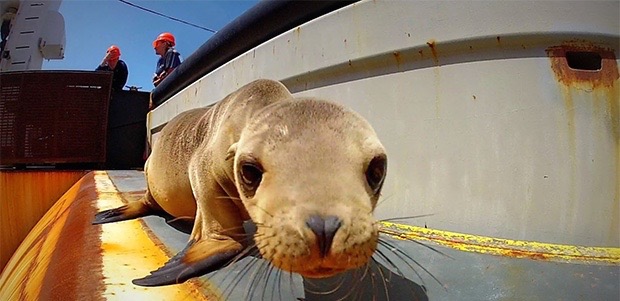For the next week, Scripps’ remotely-operated vehicle (ROV) will be aboard Sally Ride. Named Trident after UC San Diego’s mascot, it’s rated to a depth of 2,000 meters. Technicians from SIO plan to deploy the ROV each day using a small crane bolted to the port side of the ship. The control center is in a converted shipping container also bolted to … Read More
Crew Introductions: Second Engineer
“Not many people can say they love their job, that they like to work. I can.” Second engineer Sue Swader has been on the water since infancy, and loves it. Her grandparents have a sailboat and she spent summers sailing with her family to the Channel Islands, including Catalina and Santa Cruz. When she’s not working on the water, she’s playing on it – … Read More
Multi-Corer Trials
As part of this science verification cruise, groups from Scripps, WHOI, Oregon State, Sacramento State, URI, CSU Bakersfield, and the USGS are testing out various coring devices using R/V Sally Ride. This requires a very specific setup on the fantail, with two small cranes bolted down for fine-tune positioning of the heavy coring equipment. Also on deck are two container vans, one … Read More
Crew Introductions: Second Mate
“This is the job I wanted…it’s just a great environment, great people, involved in interesting work that I feel is contributing to the bettering of the world. I feel like I’m part of something big here.” R/V Sally Ride’s Second Mate Randy Christian came to the maritime industry via a circuitous route. One day while taking classes at the Evergreen State … Read More
Logging Core Samples
The core samples taken so far onboard R/V Sally Ride have utilized either a 20 or 30 foot long cylinder with PVC pipe inside. Ideally, the entirety of the pipe is filled, but the amount of sediment actually recovered can vary. For example, if a layer underneath the surface of the seafloor is harder clay, the pipe may get stopped short. … Read More
Photos from the Multi-Corer
One of the many instruments onboard the multi-corer frame is a 24-megapixel camera that take flash photographs every 10 seconds. The camera belongs to the NSF-funded MISO (Multidisciplinary Instrumentation in Support of Oceanography) facility at WHOI, and is designed to visually document the area of the seafloor where core samples are taken. An added bonus of taking pictures during the descent and ascent through … Read More
Shrinking Cups!
On many research cruises, the science party creates fun souvenirs out of styrofoam cups decorated with Sharpies and then sent to the bottom of the ocean. In this case, they traveled to a depth of about 1,200 meters in a porous bag (in this case senior cook Mark relocated onions to donate to the cause) zip-tied onto the frame of the multi-corer. Styrofoam … Read More
Choosing a Coring Site
Coring operations are taking place mostly during daylight hours, with the ship running overnight survey transits. An echo sounder mounted to the bottom of the ship sends a 3.5kHz ping and records the return, producing sub-bottom profiles. These images typically show the types of sediments 20-50 meters below the ocean floor, and can capture up to 100 meters under certain conditions. The ping is a … Read More
Hitchhiker’s Guide
Have you ever considered what super powers you would choose if given the chance? Mine would be a Disney princess-like ability to befriend wild animals. The closest I ever come to this feeling is out at sea, where everything from birds to dolphins and whales get curious and come to check us out. It always pleases me when animals visit … Read More
Sediment Science
The current science verification cruise aboard R/V Sally Ride will test the ship’s ability to support coring operations. Seafloor sediment cores reveal information about the history and behavior of off-shore fault systems. They also provide insights into what the climate was like thousands of years ago. Scientists from multiple institutions are working together to collect and process cores, including students … Read More










